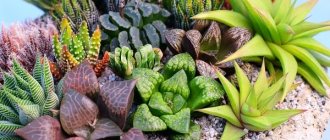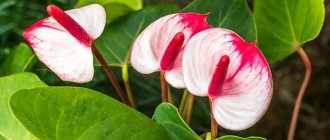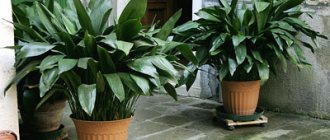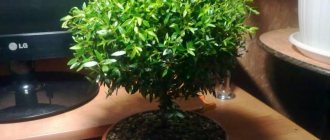Spathiphyllum (Spathiphyllum) from the Araceae family is a close relative of Anthurium and Alocasia and is a magnificent plant native to the hot and humid tropical forests of Central and South America.
In our homes, these beautiful flowers not only decorate the interior, but also create a good atmosphere, as they have the ability to purify the air from toxic substances emitted by furniture and household appliances.
The most common species are those with dark green leaves. White bracts in the form of a blanket are located around the inflorescence-cob. With proper care, flowering can last for several months.
In Western countries, the plant is called the “peace lily”, drawing an analogy between the shape and color of the bract and the white flag of truce.
Spathiphyllum - care, photo, transplantation, flowering
Spathiphyllum - care, photo, transplantation, flowering,
Homeland of the plant
. Central America.
Description
. The genus "spathiphyllum" or female happiness consists of approximately 35 species of perennial, herbaceous, evergreen plants. The leaves are basal, on long, thick petioles, spear-shaped, up to 25 cm long, dark green, glossy. The flowers are small, collected in an inflorescence - a spadix, surrounded by a large blanket of white, red, yellow, orange, pink or even almost black. Each flower can last for several weeks. There are variegated species.
Spathiphyllum "Picasso" - Spathiphyllum "Picasso"
A relatively recently bred variety, which is a variegated spathiphyllum up to 50 cm high with basal glossy leaves, colored in a wide variety of combinations of green and white; each leaf of this plant is unique. This species blooms just like ordinary spathiphyllums; it only needs very good lighting to maintain its bright color.
Spathiphyllum "Sensation" - Spathiphyllum "Sensation"
The largest variety with large, hard, glossy, dark green, oblong-lanceolate leaves. The flowers are collected in an inflorescence - a spadix - and are surrounded by a large white blanket. Flowering is very long, but occurs only in good lighting conditions.
Spathiphyllum "Domino" - Spathiphyllum "Domino"
Relatively compact variety. The plants have long and narrow, hard, dark green leaves with long petioles. The leaf blades are glossy, covered with small, white and light green stripes and spots. The flower bedspreads may also have stripes of a green tint.
Spathiphyllum Chopin - Spathiphyllum "Chopin"
A beautiful large spathiphyllum with abundant and very long flowering. The leaves are on strong long petioles, the leaf blades are oblong, glossy, dark green in color, with pronounced branched veins.
Spathiphyllum Cupido - Spathiphyllum "Cupido"
Small evergreen perennial plants, reaching a height of 15 - 30 cm. Leaves with slightly corrugated edges, emerald green. The flowering is abundant and long-lasting, the flowers have large, creamy-white spathes, but as they fade they can turn green
Spathiphyllum Alana - Spathiphyllum Alana
An elegant variety with bright green oblong leaves. The flowers' spathes are small, pointed, greenish-white. The plant reaches a height of 30 cm.
Spathiphyllum Angel Baby - Spathiphyllum "Angel Baby"
A beautiful variegated perennial spathiphyllum with narrow, thin leaves, painted predominantly in a delicate light green color with thin dark green stripes. The midrib is usually highlighted in a dark shade of green.
Spathiphyllum red can easily be confused with anthurium.
Height
. The spathiphyllum flower, depending on the variety, can grow up to 20 - 60 cm. It develops quickly.
Temperature conditions
. Spathiphyllum does not have a pronounced dormant period and is kept warm all year round. During the winter months, the temperature should not fall below 16°C.
Lighting
. Spathiphyllum requires a brightly lit location with plenty of reflected sunlight. Rotate the plant pot ¼ turn every week to prevent the plant from tilting toward the light source.
Care
. Peduncles with fading flowers are cut off at the base. Remove old, wilted leaves. Wipe the leaves with a damp sponge to remove dust.
Soil for spathiphyllum
. For cultivation, a mixture based on peat and leaf humus with the addition of river sand or perlite to improve drainage, small pieces of pine bark and charcoal is suitable.
How to feed spathiphyllum
. From spring to fall, feed with water-soluble fertilizer every 2 weeks. During the winter months, plants slow down and do not need fertilizing. As a top dressing, you can sometimes use simple granulated sugar, which is scattered over the surface of the soil.
Purpose
. Spathiphyllum is a valuable ornamental flowering plant with a long flowering period and a wide variety of colors.
Spathiphyllum flowering time
. In spring and summer, indoor spathiphyllum blooms willingly and for a long time. With proper care, plants can bloom almost continuously. To stimulate the onset of flowering, plants are kept in a cool room at a temperature of about 18 ° C for 2 - 3 months.
Air humidity
. Spathiphyllums love high air humidity - use a room humidifier or a tray with wet pebbles. You can spray the leaves with water at room temperature. Plants cannot tolerate cold drafts.
Spathiphyllum watering
. Water in such a way that the top layer of soil dries out before subsequent watering to a depth of about 3 cm. In autumn, the frequency of watering is reduced, and in the winter months, if the plants are kept cool, water very sparingly, not allowing the soil to dry out completely. For irrigation, you should use only settled water at room temperature.
Spathiphyllum transplant
. Plants need replanting approximately every 2 years. If the roots have filled the entire volume of the pot or the soil needs to be replaced with fresh soil, you can transplant it into a slightly larger pot in the spring.
Reproduction of spathiphyllum
. Spathiphyllum propagates quite easily by division during transplantation. Each division should have 2 - 3 leaves and a developed root system.
Pests and diseases
. If there is a lack of sunlight, spathiphyllum does not bloom. The leaves wrinkle and turn yellow when the soil is allowed to dry out for a long time. Plants rot when there is insufficient drainage or excessive watering, especially in autumn and winter. Brown leaf tips may indicate direct sunlight during the day, overwatering, or excess minerals in the soil. Spider mites, aphids, mealybugs, thrips.
Note
. All parts of the plant are toxic - keep it away from children and pets. Wash your hands thoroughly after contact with the plant. Old specimens may not bloom so profusely; it is worth dividing the plants for rejuvenation. Spathiphyllum is able to purify indoor air from harmful impurities.
Hydroponics
. Grows well in hydroponics.
Types and varieties
There are quite a few varieties of the crop, which differ from each other mainly in the shade of flowers and foliage.
Some of the most popular varieties in indoor gardening come from the species Spathiphyllum wallisii, which first came to Europe in 1824 after being found in the Colombian jungle by the German collector Gustav Wallis.
Spathiphyllum wallisi
No less popular is the Floribundum (Spathiphyllum floribundum) and its varieties, as well as the lovely Spathiphyllum (S. blandum Schott), which blooms as profusely as other species.
The new variety 'Domino' and the hybrid 'Variegata' have white inflorescences and striking variegated foliage. Miniature varieties about 30 cm tall are beautifully presented, for example the extremely compact “Mini” or “Strauss” with fragrant flowers.
Their opposite is the magnificent Mauna Loa hybrid, which grows up to 1 meter. The range of sizes allows you to choose the appropriate copy for different rooms.
Hybrid "Variegata"
Spathiphyllum
- Hydnostachyon Liebm. , 1849
- Massovia C.Koch, 1852
- Spathiphyllopsis Teijsm. & Binn. , 1863
- Amomophyllum Engl. , 1877
Spathiphyllum
, or
Spathiphyllum
(lat. Spathiphyllum), is a genus of perennial evergreen plants of the Araceae family (
Araceae
), some representatives are popular indoor plants.
The name of the genus comes from two Greek words: σπάθη ( spathe
) - “blanket” and φύλλον (
phyllon
) - “leaf”.
Description [edit | edit code ]
Perennial evergreens. Mostly terrestrial, but among them there are epiphytes and hemiepiphytes.
There is no stem - the basal leaves form a bunch directly from the soil.
The leaves are oval to lanceolate, entire, with a clearly visible midrib and thin parallel laterals. The petiole is elongated, equipped with a sheath up to the middle of the length or to the base of the leaf blade, with swollen vessels at the base of the leaf.
The peduncle is equal to or exceeds the length of the petiole. The inflorescence is a spadix with a veil at the base. The spathe is oblong-elliptical, longer than the cob, green to white, not falling off. The white blanket quickly turns green after flowering. The cob is sessile to pedunculated. The flowers are bisexual, enclosed in two circles of fused perianth petals; stamens 6; The ovary is three-locular with 1-7 ovules in each nest.
Homeland of the plant
The magnificent exotic species lives in the wild in the subtropics and tropics of South America and Asia . The areas of Colombia, Malaysia, the Amazon basin and the Solomon Islands can boast of species diversity.
Favorite places are moist equatorial forests, coastal areas, river valleys, lakes and reservoirs. In their natural environment, plants live as terrestrial “inhabitants”; some species with creeping roots are epiphytes and heliepiphytes (they cling to supports such as trees, stumps, stones).
Cultivation [edit | edit code]
Spathiphyllum is a heat-loving plant; it grows well only at temperatures above 18 °C; the ideal temperature for growth is 22-23 °C. Doesn't like drafts.
Good lighting is required, but it is better to shade the spathiphyllum from direct sunlight.
Water abundantly in summer and moderately in winter to keep the soil slightly moist. The lump of earth should not dry out, but the plant does not tolerate stagnation of water. It is advisable to spray the leaves frequently.
Every year in the spring, the spathiphyllum is transplanted into a slightly larger pot. The soil is turf, leaf, peat, humus soil and sand in a ratio of 2:1:1:1:1. You can add charcoal and brick chips to the soil. Drainage is required.
Plant correctly.
Boarding time.
The Zelmira lily is an OT hybrid; the best time for planting is autumn, but the choice is ambiguous - both spring and autumn.
Read more in the article
Landing dates
How to plant correctly.
When planting bulbs, leave space 35-40cm apart from each other, 60-70cm between rows. The planting depth is equal to h3 of the bulb itself. The plant is powerful and loves to feed to its heart’s content, so don’t skimp on space or feed it extra.
The place is prepared in advance two weeks before planting. The soil is dug up on the bayonet of a shovel and loosened well. Add sand and old humus if necessary. Fresh compost and manure cannot be added for planting. When planting, be sure to add sand to the hole so that the bulb sits in a sand bag.
For more details on how to plant, read the article - Planting lilies in open ground.
Legends [edit | edit code]
Spathiphyllums bred for decorative purposes at home in Russia are sometimes called “women’s happiness” in everyday life and a number of superstitions and signs are associated with them [5] [6] [7] [8]. According to legend, the goddess of love Astarte breathed into the flower a piece of happiness that overwhelmed her on her wedding day, so that the flower would bring happiness to every girl who believed in its power. One of the superstitions says that if you keep pots of anthurium and spathiphyllum nearby or even transplant them into one pot, you can achieve harmony in family relationships. However, these plants require different conditions. [8]
In contrast to spathiphyllum, anthurium is called “male happiness” [9].
How to choose
Before purchasing, you should consider the flower catalog and the description of the plants in it. In the store, the bulbs are carefully examined. The bottom should be dry and clean, the scales adjacent to each other. There are no growths, cracks, ulcers or other defects.
The article cannot convey all the variety of species and varieties of lilies. But perhaps after reading it will be easier to find a suitable option for a specific climate, soil type, and light level. In order for a flower to become a decoration of the garden, other nuances are also taken into account - color compatibility with other plants and the potential height of the bush. Knowing what species a lily belongs to, you can understand how to care for it. If all conditions are met, the garden will be filled with beauty and aroma all summer long.
The magic of the flower “female happiness”. Signs and superstitions associated with spathiphyllum
Many legends and traditions are associated with spathiphyllum. The exquisite flower fascinates with its unfading luxurious greenery and snow-white sail flowers. The cleanliness and freshness of the delicate bedspread, the coloring of gentle tones inspire calm and tranquility. In America, the plant is called the Peace Lily, the Peace Lily. What is the essence, secret and magic of the “female happiness” flower? Let’s talk in more detail.
Bouquets of white lilies
Because of their symbolism and special beauty, snow-white lilies take second place in popularity in wedding floristry, second only to the luxurious queen of flowers. They look harmonious in mono-bouquets, in combination with lilies of other colors and various flowers, including roses.
And about other popular flowers that can beautifully decorate any wedding celebration, read an interesting article on our website.
Snow-white mono-bouquets are the best choice for the most special occasion (wedding, anniversary). Diluted with sprigs of decorative greenery, they will look especially elegant and aristocratic. The advantage of such compositions for a wedding is that they go perfectly with any color of the bride’s dress. A wedding bouquet of white and pink lilies will look especially sophisticated and feminine. This composition will perfectly emphasize the romantic appearance of the bride.
A beautiful contrast will be provided by the combination of snow-white flowers with a tiger lily, receiving which as a gift (if you believe the signs) promises prosperity. Compositions that combine Asian hybrids with large snow-white and spotted flowers will look no less beautiful.
The combination of white lilies in bouquets with roses will be most harmonious if the queen’s petals are pink. Beautiful spherical compositions will be obtained when combined with gerberas of any color. You can also combine snow-white lilies with lush chrysanthemums of the same color. Such a composition will be refined and at the same time sincere, reflecting notes of tenderness.
White lilies are true beauty queens in the lily family. They delight and fascinate, captivate and captivate even in photographs. Admiring their pictures as a laptop screensaver or inhaling the unique aroma of these flowers in bouquets, it is easy to understand why these snow-white beauties are given only to loved ones. Topkafe is waiting for your comments about these beautiful flowers. Do you like white lilies?
Editor's note: This article has been updated since its original publication on August 24, 2022.
All beliefs associated with spathiphyllum
The etymology of the name spathiphyllum goes back to Ancient Hellas. The literal translation is “blanket-leaf”, “snow-white leaf”. The flower is called the Sailboat of Happiness, White Leaf . And by the timing, nature, and form of flowering, it turns out that one can predict in which direction the tropical resident will direct the sails of happiness. So, first things first.
Why does it bloom?
It is known that all house plants bloom only in a favorable atmosphere. Elegant exotic flowers with abundant blooms thank you for your work and care. Snow-white flower-sails foreshadow stable prosperity, peace and comfort in the home, setting you up for a calm, moderate pace of life, good rest and restful sleep.
What does exotic bring to women?
According to signs, spathiphyllum helps women achieve their cherished personal happiness . Single women of any age and status breed spathiphyllum in the hope of finding a happy, strong family.
This is interesting . In ancient Greek mythology, there is a story associated with spathiphyllum. The goddess Astarte, the mistress of love and power, on her wedding day descended from Olympus and gave a magical flower to the earthly girl as a symbol of eternal love.
Gifts from “female happiness”:
- The miracle plant is considered the Flower of Brides. Young girls take special care of the planted bush. According to legend, if a plant generously gifts its owner with snow-white flowers with spacious bedspreads that look like a fluttering veil, there will soon be a wedding.
- For a young couple dreaming of having a child, according to signs, the flower helps them find offspring. The swelling buds signal to the woman that her cherished wish will soon come true - a baby will appear in the family.
- The life-giving energy of bright green shiny leaves, it turns out, prevents premature withering and preserves the beauty and attractiveness of a woman.
- After a series of disappointments in love, snow-white flowers charge the atmosphere of the house with positive, attractive energy. Over time, grievances are forgotten, mental strength is restored, and life literally begins with a blank sheet of paper.
If the plant has withered
Spathiphyllum languishes from inattention and neglect due to poor care at home and formal treatment. Any living organism requires love.
According to legend, if the spathiphyllum begins to wither, it means it’s time to give it more attention and care. And in general, you need to take a closer look at what is happening to your loved ones and family members. Perhaps, in the daily bustle and pursuit of earnings, something important is slipping away? Spathiphyllum signals that tension and dissatisfaction with each other have accumulated in the house, the atmosphere is literally electrified - it is about to sparkle.
It's time to put things aside, relax somewhere in nature with the whole family and calmly have a heart-to-heart talk.
Muzhegon
Some people mistakenly call the “women’s happiness” flower “widow’s tears” (allegedly this is a literal translation from Chinese).
In fact, there was confusion - people consider Hoya to be a muzhegon. This Wax Ivy really has the energy of displacing the masculine principle in the house. Graceful spathiphyllum has nothing to do with such aggressive behavior.
Is it possible to give or give away?
To give or not to give “female happiness”:
- Women are not recommended to just give away even a small sprout from their home flower garden. It is believed that such a gift will have a negative response - disagreements and conflicts will begin in the family.
- If a girl decides to give an exotic plant as a gift to a friend or relative, she needs to purchase it on “neutral territory” - in a garden center, in an online store or from a collector. For insurance, it is recommended to take a comic symbolic payment for the gift - a few coins.
- But if it is given by a man close by blood (brother, father, uncle) to unmarried or single ladies, then things will go smoothly, and soon a man will appear in the house.
Other beliefs
It is believed that “female happiness” ignites the passion of spouses and protects against betrayal if you place pots in the bedroom.
For harmony in the family, group plantings of spathiphyllum and Anthurium are recommended. Anthurium is considered a “conductor” of “male happiness”. Despite the contrast of red and white shades, such a union will strengthen the affection of the spouses and resolve all misunderstandings and disputes.
Let's take a look at a photo of this amazing flower, and then we will continue the story about its magical properties.
Magic properties
Experts in white magic claim that spathiphyllum is endowed with special powers. Even rituals are performed to concentrate and exchange positive energy :
- On the waxing moon, on the night from Thursday to Friday, when the moonlight falls on the bush, you need to talk to the plant, tell it all its secrets and make a request.
- To attract financial well-being, it is recommended to place pots in the room where money is stored, and hide a yellow coin in a tray or in the soil from prying eyes.
Desires and thoughts should be good; the flower does not respond to “black” negative desires, the effect may be the opposite.
Planting bulbs
In order for lilies to bloom in mid-May, their bulbs are planted before the tenth of March. To obtain flowers in December, plants are cultivated from the end of September. If planting occurs in autumn, then lilies need additional lighting.
When preparing planting material for planting in a container, the following stages go through:
- Bulbs are selected without mechanical damage or rot. If there are rotten spots, they are cut off with a sharp knife or razor. The cut is sprinkled with fine charcoal.
- Before planting the bulbs, keep them in the refrigerator for two weeks. This is necessary for better germination.
- Then it is recommended to keep the bulbs for about two hours in a solution of potassium permanganate. And then leave it for 12 hours in a growth stimulator solution.
Drainage is poured into the bottom of the pot. This can be large pebbles, broken bricks or expanded clay. Then pour the earthen mixture into 1/3 of the container. Do not compact the soil too much. Light pats are enough. After this, the bulbs are placed in a container. The bottom should be at the bottom, the top should be at the top. Next, the bulbs are covered with the remaining soil. The tips of their bulbs should stick out above the soil surface. When indoor lilies begin to grow, add soil to the pot. There should be 2-3 cm from the edge of the container to the soil surface.
Why does spathiphyllum cry?
According to signs, “female happiness” cries from an excess of feelings (on the eve of a celebration, anniversary, wedding).
“Tears of enlightenment and reconciliation” can be observed on pieces of paper after a long quarrel, or the resolution of a protracted conflict. This behavior of the flower does not pose a real threat. The main thing is to sincerely ask for forgiveness, forgive the offender, draw conclusions and move on with a pure heart.
And in the scientific community, the formation of droplets flowing to the ground is called the process of guttation . This is a natural phenomenon that protects the plant world from flooding and getting its roots wet.
Reference . Guttation is the process of removing excess accumulated liquid in the tissues and roots of a plant. This physiological phenomenon is characteristic of representatives of the tropics, where seasonal precipitation oversaturates the flora and fauna with moisture.
Why do you dream?
- The image of living flowering bushes symbolizes prosperity and success, stable income and good luck in love affairs.
- Artificial flowers seen in a dream speak of a hypocritical environment, “artificial”, insincere relationships, and foreshadow deception and disappointment.
- Dirty flowers , neglected appearance of the bush signals mental confusion, disharmony and loss of taste for life. Perhaps such a vision is a consequence of the work of the subconscious. It is important to understand your feelings, “clean” your thoughts, find new resources and goals, and then gradually everything will come together.
Feng Shui meaning
Feng Shui – (literally “wind and water”) – is an ancient Chinese practice (Taoist geomancy) of mastering space through the “way of things” and symbols, using flows of positive energy to achieve harmony and well-being.
Feng Shui experts say that spathiphyllum has incredible creative active energy.
Luxurious rich green foliage is the energy of life, growth and development. And snow-white flowers are a symbol of purity and innocence. Such a harmonious combination will protect the house from the penetration of the black destructive force, the evil eye and envy.
Where is the best place to put it?
Pots and flowerpots are installed in a bright room, on south-eastern and south-western window sills . Spathiphyllum loves diffused soft light. Aggressive direct rays, especially in summer or early spring, leave brown dry burn spots on bright leaves.
In conclusion, it should be noted that spathiphyllum, a seeker of female happiness, will definitely bring good luck. You just need to try a little, take care of him, share your care and love and believe in a miracle.
Flower in landscape design
Lily is common in landscape design. There are different options for using garden crops on the site:
- in the form of a solo planting;
- in flower groups;
- in containers;
- under the crowns of plants that do not create shade.
In flower beds, the lily acts as a bright accent, combining well with evergreen shrubs, border plants, and tall flowers - delphiniums, gladioli, phlox. The flower is sometimes planted near ponds and in rockeries. The flowerbed on which lily varieties are planted looks interesting: the variety of shades, stem heights, and bud sizes is admirable.











